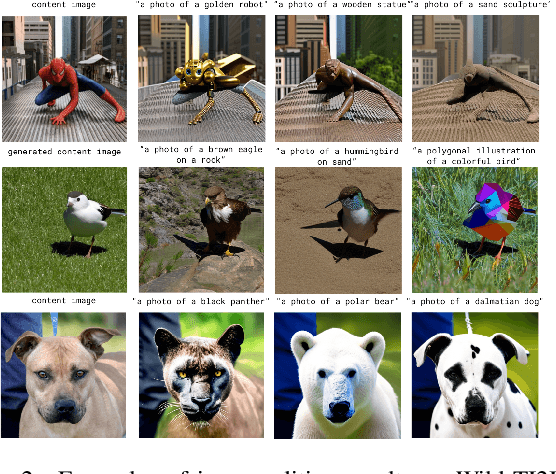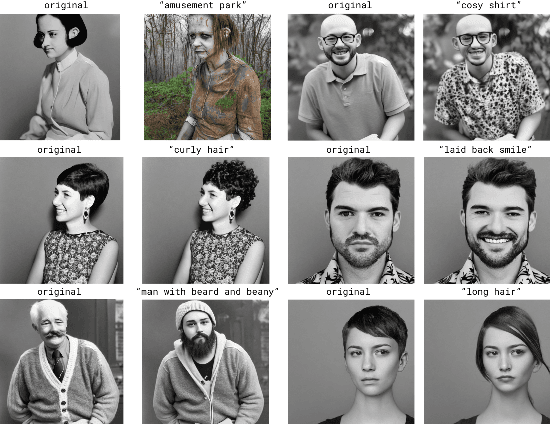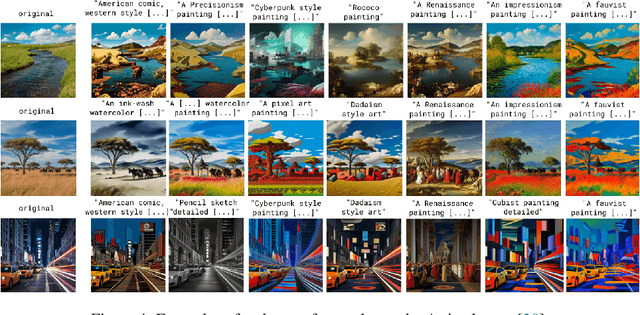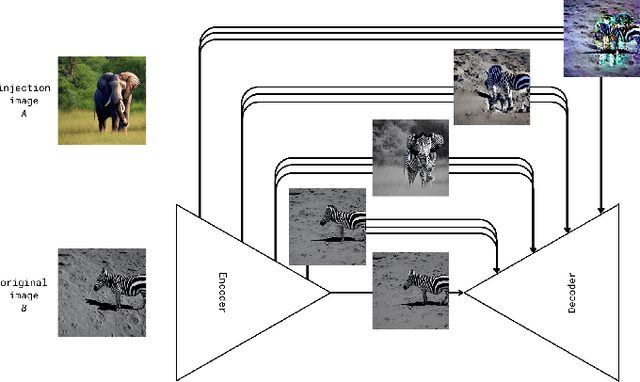Ludovica Schaerf
Training-Free Style and Content Transfer by Leveraging U-Net Skip Connections in Stable Diffusion 2.*
Jan 24, 2025



Abstract:Despite significant recent advances in image generation with diffusion models, their internal latent representations remain poorly understood. Existing works focus on the bottleneck layer (h-space) of Stable Diffusion's U-Net or leverage the cross-attention, self-attention, or decoding layers. Our model, SkipInject takes advantage of U-Net's skip connections. We conduct thorough analyses on the role of the skip connections and find that the residual connections passed by the third encoder block carry most of the spatial information of the reconstructed image, splitting the content from the style. We show that injecting the representations from this block can be used for text-based editing, precise modifications, and style transfer. We compare our methods state-of-the-art style transfer and image editing methods and demonstrate that our method obtains the best content alignment and optimal structural preservation tradeoff.
Reflections on Disentanglement and the Latent Space
Oct 08, 2024



Abstract:The latent space of image generative models is a multi-dimensional space of compressed hidden visual knowledge. Its entity captivates computer scientists, digital artists, and media scholars alike. Latent space has become an aesthetic category in AI art, inspiring artistic techniques such as the latent space walk, exemplified by the works of Mario Klingemann and others. It is also viewed as cultural snapshots, encoding rich representations of our visual world. This paper proposes a double view of the latent space, as a multi-dimensional archive of culture and as a multi-dimensional space of potentiality. The paper discusses disentanglement as a method to elucidate the double nature of the space and as an interpretative direction to exploit its organization in human terms. The paper compares the role of disentanglement as potentiality to that of conditioning, as imagination, and confronts this interpretation with the philosophy of Deleuzian potentiality and Hume's imagination. Lastly, this paper notes the difference between traditional generative models and recent architectures.
Art Forgery Detection using Kolmogorov Arnold and Convolutional Neural Networks
Oct 07, 2024Abstract:Art authentication has historically established itself as a task requiring profound connoisseurship of one particular artist. Nevertheless, famous art forgers such as Wolfgang Beltracchi were able to deceive dozens of art experts. In recent years Artificial Intelligence algorithms have been successfully applied to various image processing tasks. In this work, we leverage the growing improvements in AI to present an art authentication framework for the identification of the forger Wolfgang Beltracchi. Differently from existing literature on AI-aided art authentication, we focus on a specialized model of a forger, rather than an artist, flipping the approach of traditional AI methods. We use a carefully compiled dataset of known artists forged by Beltracchi and a set of known works by the forger to train a multiclass image classification model based on EfficientNet. We compare the results with Kolmogorov Arnold Networks (KAN) which, to the best of our knowledge, have never been tested in the art domain. The results show a general agreement between the different models' predictions on artworks flagged as forgeries, which are then closely studied using visual analysis.
ColorwAI: Generative Colorways of Textiles through GAN and Diffusion Disentanglement
Jul 16, 2024Abstract:Colorway creation is the task of generating textile samples in alternate color variations maintaining an underlying pattern. The individuation of a suitable color palette for a colorway is a complex creative task, responding to client and market needs, stylistic and cultural specifications, and mood. We introduce a modification of this task, the "generative colorway" creation, that includes minimal shape modifications, and propose a framework, "ColorwAI", to tackle this task using color disentanglement on StyleGAN and Diffusion. We introduce a variation of the InterfaceGAN method for supervised disentanglement, ShapleyVec. We use Shapley values to subselect a few dimensions of the detected latent direction. Moreover, we introduce a general framework to adopt common disentanglement methods on any architecture with a semantic latent space and test it on Diffusion and GANs. We interpret the color representations within the models' latent space. We find StyleGAN's W space to be the most aligned with human notions of color. Finally, we suggest that disentanglement can solicit a creative system for colorway creation, and evaluate it through expert questionnaires and creativity theory.
Synthetic images aid the recognition of human-made art forgeries
Dec 28, 2023Abstract:Previous research has shown that Artificial Intelligence is capable of distinguishing between authentic paintings by a given artist and human-made forgeries with remarkable accuracy, provided sufficient training. However, with the limited amount of existing known forgeries, augmentation methods for forgery detection are highly desirable. In this work, we examine the potential of incorporating synthetic artworks into training datasets to enhance the performance of forgery detection. Our investigation focuses on paintings by Vincent van Gogh, for which we release the first dataset specialized for forgery detection. To reinforce our results, we conduct the same analyses on the artists Amedeo Modigliani and Raphael. We train a classifier to distinguish original artworks from forgeries. For this, we use human-made forgeries and imitations in the style of well-known artists and augment our training sets with images in a similar style generated by Stable Diffusion and StyleGAN. We find that the additional synthetic forgeries consistently improve the detection of human-made forgeries. In addition, we find that, in line with previous research, the inclusion of synthetic forgeries in the training also enables the detection of AI-generated forgeries, especially if created using a similar generator.
Art Authentication with Vision Transformers
Jul 10, 2023Abstract:In recent years, Transformers, initially developed for language, have been successfully applied to visual tasks. Vision Transformers have been shown to push the state-of-the-art in a wide range of tasks, including image classification, object detection, and semantic segmentation. While ample research has shown promising results in art attribution and art authentication tasks using Convolutional Neural Networks, this paper examines if the superiority of Vision Transformers extends to art authentication, improving, thus, the reliability of computer-based authentication of artworks. Using a carefully compiled dataset of authentic paintings by Vincent van Gogh and two contrast datasets, we compare the art authentication performances of Swin Transformers with those of EfficientNet. Using a standard contrast set containing imitations and proxies (works by painters with styles closely related to van Gogh), we find that EfficientNet achieves the best performance overall. With a contrast set that only consists of imitations, we find the Swin Transformer to be superior to EfficientNet by achieving an authentication accuracy of over 85%. These results lead us to conclude that Vision Transformers represent a strong and promising contender in art authentication, particularly in enhancing the computer-based ability to detect artistic imitations.
Newly Formed Cities: an AI Curation
Jun 06, 2023



Abstract:Art curatorial processes are characterized by the presentation of a collection of artworks in a knowledgeable way. Machine processes are characterized by their capacity to manage and analyze large amounts of data. This paper envisages machine curation and audience interaction as a means to explore the implications of contemporary AI models for the curatorial world. This project was developed for the occasion of the 2023 Helsinki Art Biennial, entitled New Directions May Emerge. We use the Helsinki Art Museum (HAM) collection to re-imagine the city of Helsinki through the lens of machine perception. We use visual-textual models to place artworks currently hosted inside the museum in outdoor public spaces of the city, assigning fictional coordinates based on similarity scores. Synthetic 360{\deg} art panoramas are generated using diffusion-based models to propose a machinic visual style guided by the artworks. The result of this project will be virtually presented as a web-based installation, where such a re-contextualization allows the navigation of an alternative version of the city while exploring its artistic heritage. Finally, we discuss our contributions to machine curation and the ethical implications that such a process entails. The web-based installation is available at this link: http://newlyformedcity.com/.
 Add to Chrome
Add to Chrome Add to Firefox
Add to Firefox Add to Edge
Add to Edge